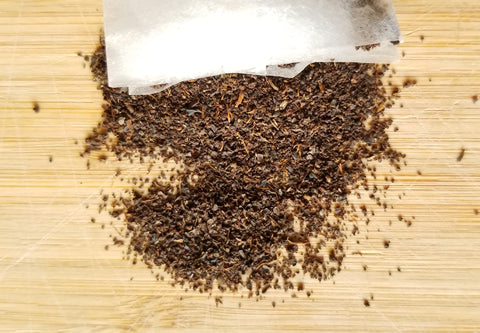Why You Should Switch from Teabags to Loose Leaf
In a 2019 study, it was uncovered that teabags release millions of microscopic plastic particles into your cup, due to the polypropylene used to seal the bags. If you are someone who relies on teabags to get you through the day, imagine how much plastic you unknowingly ingest on a daily basis.
Yikes. Time to re-assess our brewing habits!
In this post I'll discuss what's inside your teabag, the 3 main benefits of loose leaf, and simple ways you can make the switch.
Teabags
First, let's talk about teabags: An accidental invention by an American tea merchant in the early 1900s and the modern world's favorite way to enjoy a hot brew.
But what actually goes inside the bag? I thought it'd be a fun exercise to cut open some teabags and show you. As you will notice in the photo below, the bags contain very small, broken pieces of tea, almost like a powder. In the producer's world, this is called "fannings" or "dust" grade.

Cut-open teabags: Twinings English Breakfast & Rickshaw Oolong
To give you some context: Once tea leaves have been plucked and processed, tea factories will sort the various grades starting from premium tips and whole leaves down to broken-leaf grades. What's left as a result are tiny remnants of the leaf known as dust grade, kind of like the crumbs at the bottom of a chips bag. Instead of disposing this grade, as was traditionally done, producers will sell them to teabag companies.
Since teabags are all about convenience, dust grade makes sense: A larger surface area for a shorter infusion time. However, as the name implies it's typically low-quality, resulting in an unpleasant and bitter brew when consumed plain. And most of the flavor is extracted within the first infusion, leaving us with a disappointing re-brew at best.

A peek inside an English Breakfast teabag
But hold on - what about those pyramid-shaped sachets that contain whole leaf tea? Aren't they a good solution? Sorry to be the bearer of bad news! They actually contain the highest amount of plastic due to the nylon mesh material, according to McGill University research discussed in this article. Brew at your own risk.
Loose Leaf Tea

Now onto the good stuff. Ever since I started drinking tea on a more serious level in 2013, I've been a loyal advocate of loose leaf tea. Ask any tea aficionado and they'll agree there's nothing quite as satisfying as brewing tea directly from the leaves. The smell, the taste, the unfurling leaves... We love every bit of it.
Loose Leaf Benefits
Benefits include:
- Higher-quality teas
- Joy of tea appreciation
- Sustainability & Health
Try our selection of loose leaf teas here.
Higher Quality
Switching to loose leaf is a huge upgrade. By brewing loose leaf, you gain access to a world of significantly higher quality teas. Two leaves and a bud is the general picking standard, and you'll even find extra fine, bud-only teas that you would never encounter in a teabag.
This translates to a fresher aroma, more elegant flavors, longer lasting taste, and the ability to re-brew multiple times. So even though you may be paying a higher price per gram, you'll get more bang for your buck when you take re-brewing into consideration.
If you ever do get the chance to do a side-by-side taste comparison of a breakfast teabag vs whole leaf black tea, I highly recommend it. While teabags typically fall flat in flavor and leave a dry feeling in your throat, a good whole leaf tea will be smooth, aromatic and have a long-lasting flavor. Tasting them side by side will really highlight this contrast.
Tea Appreciation

The other reason I love to brew loose leaf is that I truly cherish the experience. Living in today's fast-paced society, brewing tea is my way of slowing down and appreciating nature within the confines of the city.
By engaging with tea through our senses - sight, smell, taste - we can learn to be fully present in the moment. As I watch the leaves dance around the vessel and breathe in the fresh aroma, I feel grounded. I admire the details, such as a perfect red edge along an Oolong leaf, or the white furs on a tender white tea bud. This appreciation can really elevate the enjoyment of brewing tea.
Health & Environment
Last but not least comes the topic of sustainability.
Loose leaf teas can be directly composted and are arguably better for the environment since no single-use materials are involved in the brewing process, reducing the amount of waste.
Plus, as we learned, loose leaf is much healthier for our bodies since we avoid the harmful microscopic plastic particles contained in teabags. Many of the natural benefits of the tea leaf - like antioxidants and polyphenols - are also lost when tea is crushed into dust, meaning that if you are drinking teabags for health, think again.
Want to try our loose leaf teas?
We source all our teas directly from farms, freshly harvested, packaged and mailed to your home. Try our loose leaf teas here.
For beginners, we recommend the Starter Tea Sampler, as it allows you to sample various flavors and tea types.
How to make the switch
Okay, so maybe you're convinced that loose leaf is the way to go. But you're wondering how to make the switch.
The good news is there are many well-designed gateway tools to help you transition.
As a general rule of thumb, use 1 tsp of tea for a mug, and steep in hot water for 3-5 mins.
1. The Tea Infuser
First and foremost is the tea infuser. These come in various shapes and sizes but the basic idea is to place the loose leaves inside an enclosed infusion chamber, and then submerge into hot water. The filter lets the tea through but keep the leaves inside.
Our tea infuser filled with loose leaf lemongrass
Slide the chamber door shut, steep and enjoy
The benefit of using an infuser is they are convenient brewing tools that you can take around with you (to the office, on your travels etc) that can be cleaned and re-used easily.
One thing to note: Because the space of the chamber is limited, this method works better for smaller cut teas, like a breakfast black tea or some herbal teas. For larger leaf teas like Oolongs, which need space to unfurl, I would recommend an infusion mug or a teapot with a built-in filter (up next!).
Interested in our tea infuser? Learn more here.
2. Teapot with built-in filter
Next up, I would suggest a teapot with a built-in filter. There's a world of teapots out there to choose from. Find yourself one that's the right size, has a good infuser and consistent pour.
When brewing for one person, I'd suggest a teapot that holds 300ml or less. In general, a smaller teapot will produce a better brew (that's why traditional yixing teapots are so tiny). Try to avoid the large ceramic ones you typically find at afternoon tea or dimsum if you're brewing for yourself.
Steeping Oolong tea in our mini glass teapot
Personally I love glass teapots with simple coil strainers. The glass allows you to watch the color change as the tea infuses, which is both beautiful and helps gauge when the tea is ready. And the coil strainers allow a filter-out system, giving more space for the leaves to unfurl. The result is a high quality brew and a beautiful visual experience.
Check out our mini glass teapot here.
3. Mug with Infuser
Finally we have infuser mugs: The ultimate office brewing companion. These come in various materials (glass, stainless steel, ceramic), but the basic idea is a mug with removable infuser basket.

Place the loose leaf tea inside the basket and then steep in the mug.

Remove the basket and place onto the drip-tray-lid

Violas! Your tea is ready.
A convenient way to brew good tea. The advantage of a mug with infuser is that you can drink directly from the mug and the basket is large enough for any type of tea to unfurl. Keep one at your office and rinse it out at the end of each day.
They are not as mobile as the infusers, which can be brought on-the-go, but are great for home or office one-person brewing.
You're now equipped to start brewing loose leaf! Are you ready to make the switch?
Final thoughts
I hope this post has inspired you to bid farewell to the teabag and dive into to the world of loose leaf. Word of caution: Once you do, you'll never go back!

A beautiful leaf that accidentally made it into my cup
Discussion
How do you like to brew your tea? If you have any thoughts, questions or want to share your brewing experiences, feel free to post below! We love hearing from you so don't be shy. ♥






Leave a comment